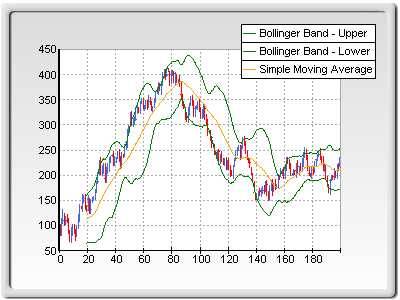Bollinger bands are displayed at a given number of standard deviations from a moving average of a price. Since standard deviation is a measure of volatility, the bands are self-adjusting: widening during volatile markets and contracting during calmer periods. Bollinger Bands were created by John Bollinger.
To display the two Bollinger bands you can use two line series (one for the upper band and one for the lower band) or a single Hi-Low series.
For the upper band use the following expression: "BOLLINGER(values, 20, 2)".
For the lower band use the following expression: "BOLLINGER(values, 20, -2)".
Mr. Bollinger recommends using "20" for the number of periods in the moving average, and using 2 standard deviations. He has also found that moving averages of less then 10 periods do not work very well.

Windows Forms: All Examples\Data Manipulation\Functions\Financial\Range Indicators
Windows Forms: All Examples\Chart Gallery\Combo Charts\Financial Chart